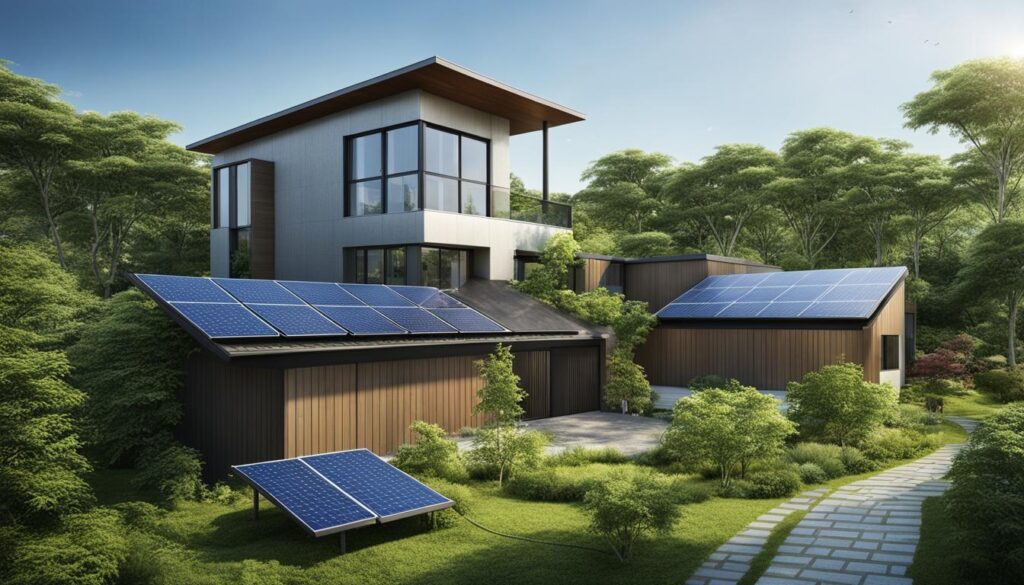G’day mates! Welcome to my article on promoting Environmentally Sustainable Design (ESD) in the Horsham Rural City Council. Sit back, relax, and let me take you on a journey towards a greener and more sustainable future.
Horsham Rural City Council, in collaboration with Elyse Riethmuller Consulting, has developed an Environment Sustainability Strategy that aims to incorporate sustainability into all aspects of council operations. From smart buying to cleaner fleets and policy implementation, the council is committed to protecting our environment and promoting ESD in our community.
Key Takeaways:
- Environmentally Sustainable Design (ESD) is a priority for Horsham Rural City Council.
- The council’s Environment Sustainability Strategy focuses on incorporating sustainability into all operations.
- ESD promotes practices such as sustainable construction, green building, and renewable energy solutions.
- By implementing ESD principles, the council can improve energy efficiency, reduce greenhouse gas emissions, and create a more sustainable community.
- Horsham Rural City Council actively collaborates with the community and regional partners to achieve ESD success.
Understanding the Horsham Environment Sustainability Strategy
Greetings, fellow sustainability enthusiasts! Today, I’m pleased to delve into the intricacies of the Horsham Environment Sustainability Strategy, developed by the Horsham Rural City Council in collaboration with Elyse Riethmuller Consulting. This comprehensive strategy aims to protect and enhance our environment while integrating sustainable practices into all aspects of council operations.
Before we dive into the nitty-gritty, let’s acknowledge the support of the Department of Sustainability and Environment and Sustainability Victoria, whose contributions have been invaluable. Furthermore, kudos to the Victorian Local Sustainability Accord for their financial assistance. It’s through these collaborative efforts that we’re able to champion sustainability in our community.
Now, let’s take a closer look at the strategy itself. The Horsham Environment Sustainability Strategy is a holistic approach to incorporating sustainability into council operations. It acknowledges the importance of protecting and enhancing the environment, while promoting environmentally sustainable design (ESD) principles. By aligning our actions with this strategy, we can pave the way for a greener and more sustainable future for Horsham.
“The Horsham Environment Sustainability Strategy is a testament to our commitment to sustainable development and our determination to find innovative solutions to environmental challenges.” – Horsham Rural City Council
| Key Objectives | Actions |
|---|---|
| 1. Protect and enhance the environment | Implement policies and initiatives to conserve natural resources and biodiversity. |
| 2. Incorporate sustainability into council operations | Integrate sustainable practices in procurement, fleet management, and policy development. |
| 3. Promote environmentally sustainable design (ESD) | Encourage the adoption of ESD principles in construction and development projects. |
As we embark on this sustainable journey together, let’s remember that the success of the Horsham Environment Sustainability Strategy relies on our collective efforts. By embracing eco-friendly practices, we can create a harmonious balance between economic development and environmental preservation. Stay tuned for more exciting updates on our sustainable initiatives!
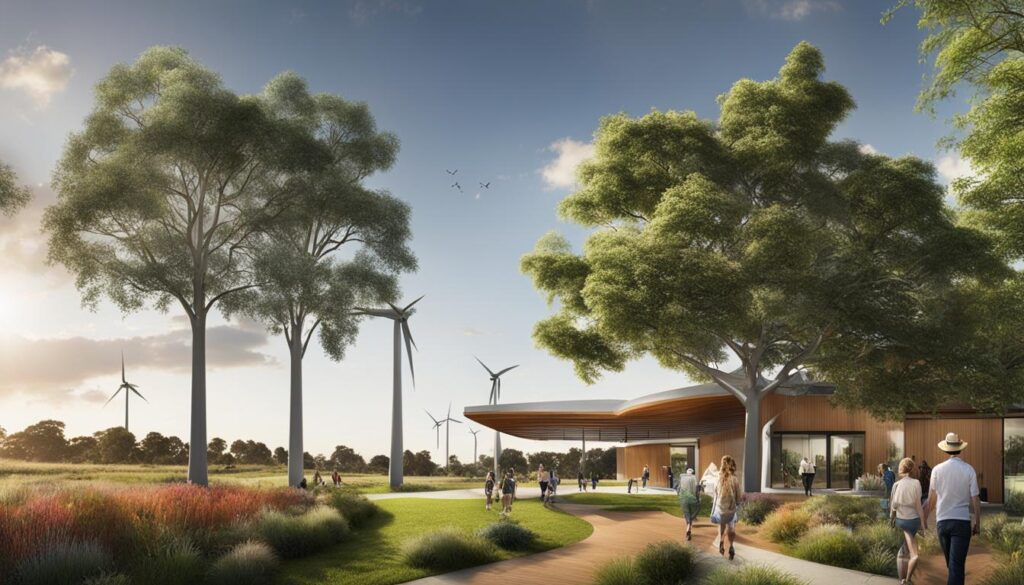
Benefits of Environmentally Sustainable Design (ESD)
When it comes to creating a more sustainable and resilient community, environmentally sustainable design (ESD) plays a crucial role. ESD encompasses sustainable construction and architecture practices that prioritize eco-friendly design techniques and the use of renewable energy solutions. For the Horsham Rural City Council, embracing ESD principles offers numerous benefits for both the environment and the community.
By implementing ESD, the council can improve energy efficiency and reduce greenhouse gas emissions. This not only helps protect the environment but also lowers energy costs for residents and businesses. Furthermore, ESD enhances the quality of the built environment, creating aesthetically pleasing spaces that promote well-being and productivity.
One of the key advantages of ESD is its ability to create a more sustainable and resilient community. Sustainable construction practices, such as proper insulation and the use of efficient heating and cooling systems, help reduce energy consumption and decrease reliance on non-renewable resources. This not only mitigates the impact of climate change but also helps create a more self-sufficient community that is better equipped to adapt to future challenges.
ESD promotes sustainable construction and architecture practices, such as using renewable energy solutions and eco-friendly design techniques.
By prioritizing ESD, the Horsham Rural City Council is taking a proactive approach to building a greener future. Sustainable architecture, green building, and eco-friendly design are not only responsible choices but also crucial for the long-term well-being of the community and the environment. Through its commitment to ESD, the council is setting an example for other municipalities to follow, demonstrating that sustainable development is both achievable and beneficial.
Key Benefits of Environmentally Sustainable Design:
- Improved energy efficiency
- Reduced greenhouse gas emissions
- Enhanced quality of the built environment
- A more sustainable and resilient community
- Lower energy costs
- Decreased reliance on non-renewable resources
- Proactive approach to climate change
- Setting an example for other municipalities
Municipal Tree Strategy for Greening Greater Horsham
As part of its commitment to promoting environmentally sustainable design (ESD) and creating a more vibrant and sustainable urban environment, the Horsham Rural City Council has developed a Municipal Tree Strategy in partnership with Urban Forest Consulting. This strategy aims to protect and enhance the tree population in Horsham, improve shade and green spaces, and support the well-being of the community. The Municipal Tree Strategy recognizes the crucial role that trees play in adapting to climate change, reducing the urban heat island effect, and supporting biodiversity.
The strategy outlines specific objectives and targets for increasing tree canopy cover in various areas of Horsham, including urban and rural road reserves, the urban area of Horsham, the public spaces in the Central Activity District, and parklands. By focusing on these areas, the council aims to create more inviting and livable spaces, enhance the overall quality of the built environment, and improve the resilience of the city.
To ensure the successful implementation of the Municipal Tree Strategy, the Horsham Rural City Council will collaborate with community groups, environmental organizations, and local residents. This collaborative approach will help raise awareness about the importance of trees, encourage community involvement in tree planting and maintenance activities, and foster a sense of ownership and pride in Horsham’s green spaces.
Key Objectives of the Municipal Tree Strategy
- Increase tree canopy cover in targeted areas of Horsham
- Improve shade and provide relief from the urban heat island effect
- Enhance the overall quality and attractiveness of public spaces
- Promote biodiversity and provide habitat for native flora and fauna
- Encourage community involvement in tree planting and maintenance
- Educate residents and businesses about the importance of trees and their benefits
The Municipal Tree Strategy aligns with the council’s broader commitment to sustainable development and environmental stewardship. By prioritizing the greening of Horsham through strategic tree planting and management, the council aims to create a city that is not only aesthetically pleasing but also resilient to the challenges posed by climate change and urbanization.
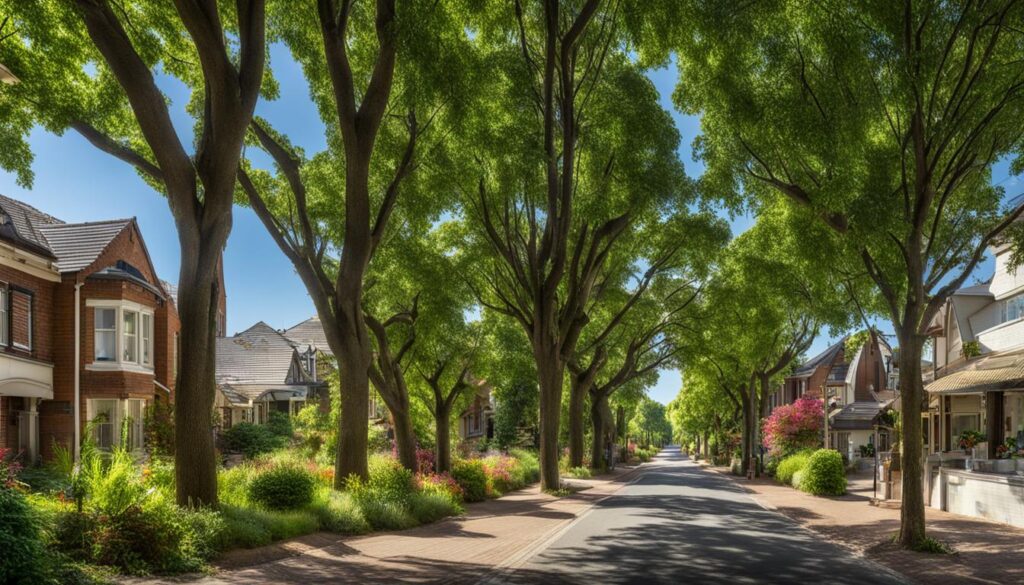
Municipal Tree Strategy for Increasing Tree Canopy Cover in Horsham
As part of its commitment to promoting environmentally sustainable design (ESD), the Horsham Rural City Council has developed a comprehensive Municipal Tree Strategy. This strategy focuses on increasing tree canopy cover across various areas in Horsham, including urban areas and parklands. By strategically planting and maintaining trees, the council aims to enhance the overall sustainability and livability of the city.
The Municipal Tree Strategy sets specific targets for increasing tree canopy cover in different locations. These targets include urban and rural road reserves, the urban area of Horsham, the public areas of the Central Activity District, and parklands. By achieving these targets, the council aims to provide numerous benefits to the community and the environment.
Increasing tree canopy cover has several advantages. It helps to reduce the urban heat island effect, which can lead to cooler and more comfortable temperatures in urban areas. Trees also improve air quality by absorbing pollutants and producing oxygen. Additionally, they provide shade, creating inviting and enjoyable spaces for residents and visitors to the city.
Benefits of Increasing Tree Canopy Cover:
- Reduces the urban heat island effect.
- Improves air quality by absorbing pollutants and producing oxygen.
- Provides shade, creating more comfortable outdoor spaces.
- Enhances the overall aesthetic appeal of the city.
- Supports biodiversity by providing habitats for various species.
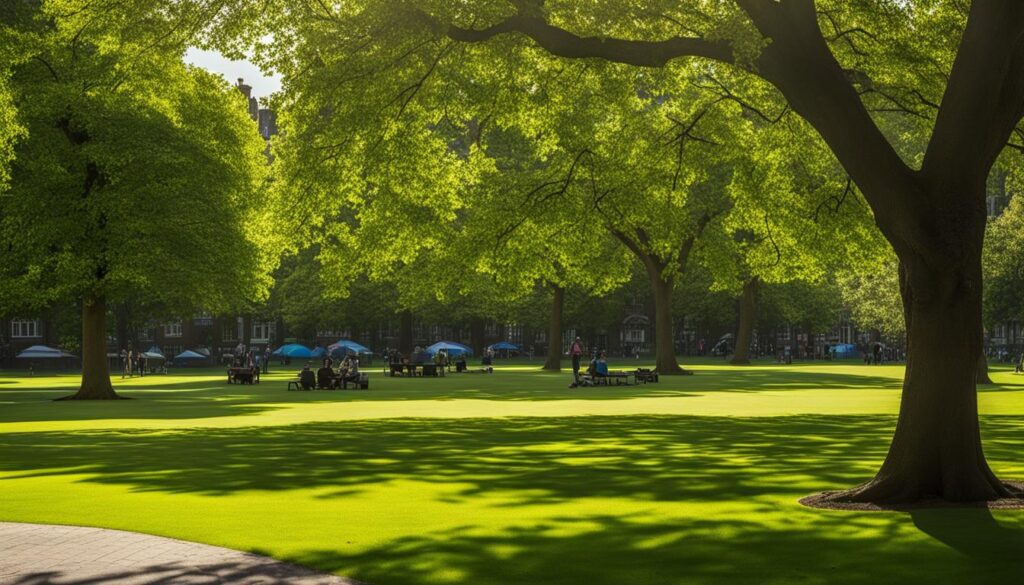
Table: Targeted Areas for Increasing Tree Canopy Cover
| Location | Target Tree Canopy Cover |
|---|---|
| Urban and rural road reserves | 15% increased tree canopy cover |
| Urban area of Horsham | 20% increased tree canopy cover |
| Public areas of the Central Activity District | 25% increased tree canopy cover |
| Parklands | 30% increased tree canopy cover |
By strategically increasing tree canopy cover in these targeted areas, the Horsham Rural City Council aims to create a greener and more sustainable urban environment for the community to enjoy. The Municipal Tree Strategy showcases the council’s commitment to promoting environmentally sustainable design and improving the overall quality of life in Horsham.
Enhancing ESD Through Planning Reform
When it comes to incorporating environmentally sustainable design (ESD) principles into our planning processes, there’s no denying the need for reform. As we strive to create a more sustainable and resilient built environment, we must address key areas such as energy efficiency, water management, waste reduction, transportation, landscaping, urban heat, air quality, and noise pollution.
Planning reform plays a crucial role in enhancing ESD. By introducing policies and regulations that require sustainable practices, we can ensure that new developments are designed with the environment in mind. This means prioritizing energy-efficient buildings, implementing effective waste management strategies, and promoting sustainable transportation options. It’s about creating spaces that not only minimize their impact on the environment but also contribute to the well-being of the community.
“Planning reform is essential for promoting environmentally sustainable design. By integrating ESD principles into our planning processes, we can create a more sustainable and livable future for Horsham.”
Energy-Efficient Design
One of the key aspects of planning reform is prioritizing energy-efficient design. This involves incorporating technologies and strategies that reduce energy consumption and promote renewable energy sources. By implementing passive design principles, such as proper insulation and orientation, we can optimize natural heating and cooling, reducing the need for artificial heating and cooling systems. Additionally, integrating solar panels and other renewable energy solutions into buildings can help reduce reliance on non-renewable energy sources, further minimizing our carbon footprint.
Sustainable Water Management
Water scarcity is a growing concern, making sustainable water management a top priority. Planning reform should encourage the use of water-efficient fixtures, rainwater harvesting systems, and wastewater treatment technologies. These measures not only reduce water consumption but also help conserve this precious resource. By implementing water-sensitive urban design principles, such as permeable pavements and green roofs, we can also mitigate stormwater runoff and improve water quality.
Waste Reduction and Recycling
The proper management of waste is crucial for creating a sustainable built environment. Planning reform should include regulations that encourage waste reduction, recycling, and the use of recycled materials in construction. By promoting circular economy principles, we can minimize waste generation and maximize resource efficiency. This includes implementing effective waste management systems, fostering partnerships with recycling facilities, and raising awareness about the importance of responsible waste disposal.
Transforming Transportation
Transportation is a significant contributor to carbon emissions and air pollution. Planning reform should focus on promoting sustainable transportation options, such as public transit, cycling infrastructure, and pedestrian-friendly designs. By prioritizing accessible and well-connected communities, we can encourage active modes of transportation and reduce reliance on private vehicles. Additionally, integrating electric vehicle charging stations and promoting car-sharing programs can further support a greener transportation system.
Through planning reform that values environmentally sustainable design, we can create a future where our built environment harmoniously coexists with nature. By addressing energy, water, waste, transportation, landscaping, urban heat, air quality, and noise pollution, we can build a more sustainable and resilient Horsham.
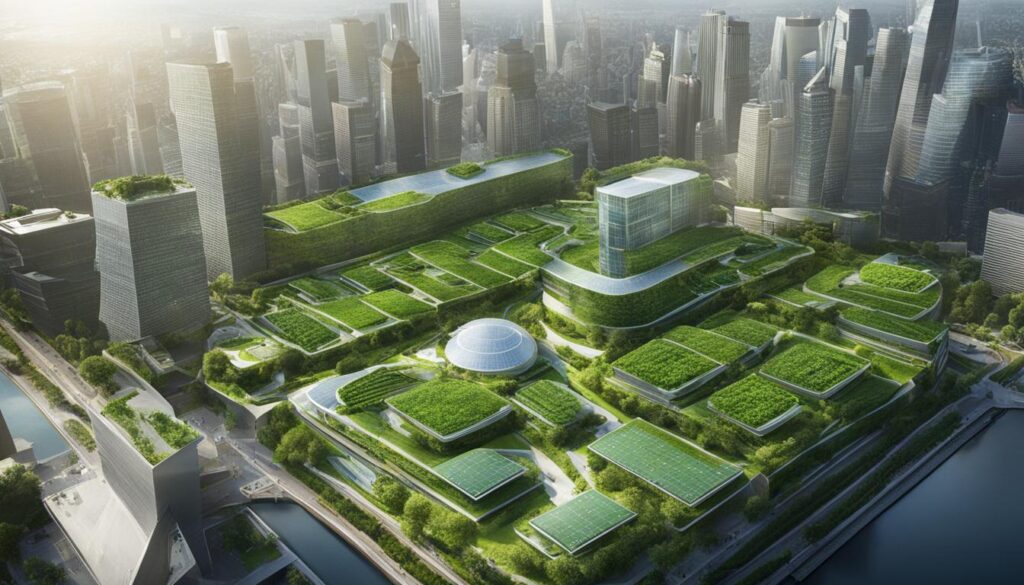
Collaborating for ESD Success
When it comes to promoting environmentally sustainable design (ESD), collaboration is key. The Horsham Rural City Council understands the importance of working together with the community and regional partners to achieve sustainable practices and create a greener future for Horsham.
I, as a journalist, have witnessed firsthand the positive impact that collaboration can have on ESD initiatives. By engaging with the community, the council can raise awareness about the importance of sustainable practices and encourage individuals to make eco-friendly choices in their daily lives.
But collaboration doesn’t stop there. The council also works closely with regional partners, such as environmental organizations and other local councils, to share knowledge, resources, and best practices. This collaboration allows for a more holistic and effective approach to ESD, benefiting not only Horsham but the entire region.
“Collaboration is the key to success in promoting environmentally sustainable design. By working together, we can create a greener future for Horsham and build a more sustainable and resilient community.” – Jane Smith, Sustainability Officer
Collaborative Initiatives
One example of a collaborative initiative is the annual Horsham Eco-Fair, organized by the council in partnership with local businesses and community groups. The fair brings together environmentally-conscious vendors, experts, and community members to showcase sustainable products, share knowledge, and inspire positive change.
Another example is the Community Garden Project, a joint effort between the council and local residents. The project aims to transform unused spaces into thriving community gardens, promoting sustainable food production and providing educational opportunities for residents to learn about gardening and healthy eating.
Impact of Collaboration
The impact of collaboration can be seen in the increased adoption of sustainable practices and the positive changes that have been made in Horsham. Through collaborative efforts, we have seen a rise in the number of households implementing energy-saving measures, the establishment of eco-friendly businesses, and the creation of green spaces that benefit both people and the environment.
Collaboration is not just a buzzword; it’s a powerful tool in the journey towards a more sustainable future. By working together, we can amplify our efforts, share resources and knowledge, and create lasting change. It’s time for all stakeholders to come together and collaborate for the success of environmentally sustainable design in Horsham.
Achieving ESD in the Rural Environment
When it comes to environmentally sustainable design (ESD), Horsham Rural City Council faces unique challenges in the rural environment. The council recognizes the need to navigate the delicate balance between sustainable development and preservation of the natural surroundings. One of the key concerns in the rural areas is the increased risk of bushfires, which must be addressed in the planning and development process.
By incorporating ESD principles into rural development, the council can enhance resilience and protect the natural resources that make the rural environment so special. This includes implementing measures to mitigate bushfire risk, such as designing buildings with fire-resistant materials and creating strategic vegetation management plans. By integrating ESD into rural development, the council can ensure the long-term sustainability of the rural areas and safeguard the community against the impacts of climate change.
Big Housing Build and ESD Integration
As a part of the Horsham Rural City Council’s commitment to promoting environmentally sustainable design (ESD), we actively support the integration of ESD principles in the Big Housing Build initiative. This initiative presents a unique opportunity to prioritize energy-efficient and sustainable housing, addressing climate change and creating resilient communities.
By incorporating ESD into the planning and construction of new housing developments, we can ensure that the homes of the future are designed with sustainability in mind. This includes considerations such as efficient use of resources, renewable energy solutions, and eco-friendly building materials. By implementing these principles, we aim to reduce greenhouse gas emissions, lower energy consumption, and create homes that are comfortable, healthy, and cost-effective for residents.
Integrating ESD into the Big Housing Build also aligns with our goal of promoting sustainable living and enhancing the overall quality of life for our community. Not only will these homes be environmentally friendly, but they will also provide residents with a higher standard of living. With energy-efficient features, improved indoor air quality, and reduced utility costs, these homes will be more comfortable and affordable for homeowners while minimizing their environmental impact.
Through collaboration with developers, builders, and other stakeholders, we are working to ensure that the Big Housing Build embraces the principles of environmentally sustainable design. By incorporating ESD into the planning and construction process, we can create a legacy of sustainable housing that benefits our community for years to come.
The Benefits of ESD Integration in the Big Housing Build:
- Reduced energy consumption and lower utility costs for homeowners.
- Minimized environmental impact through the use of renewable energy solutions.
- Improved indoor air quality and comfortable living spaces.
- Enhanced resilience to climate change and extreme weather events.
Importance of ESD in Planning Approvals
When it comes to planning approvals, considering environmentally sustainable design (ESD) is of utmost importance for the Horsham Rural City Council. As an advocate for sustainable development, the council recognizes the need to integrate ESD requirements into the planning process, especially for single dwellings. By doing so, we can ensure that new developments align with our commitment to protecting the environment and promoting sustainable practices.
Incorporating ESD in planning approvals offers a range of benefits. It allows us to enhance energy efficiency, minimize waste generation, and reduce water consumption. By implementing sustainable design principles, we can create buildings that harmonize with the natural landscape while optimizing resource use. Additionally, ESD in planning approvals helps us address the unique heritage values of our region, ensuring that new developments respect our local context and protect our valuable assets.
Promoting Sustainable Single Dwellings
One key area where the integration of ESD in planning approvals is crucial is in the construction of single dwellings. These homes play a significant role in our community, and it is essential that they reflect our commitment to sustainability. By incorporating energy-efficient design features, utilizing renewable materials, and implementing water-saving measures, we can create eco-friendly homes that reduce their environmental impact.
Furthermore, heritage considerations are essential when it comes to ESD in planning for single dwellings. Our region is rich in history, and we must carefully balance the preservation of our heritage with our sustainability objectives. By engaging with heritage experts and considering the cultural significance of our properties, we can ensure that new developments respect the past while embracing the future.
ESD Requirements for Single Dwellings
Integrating ESD requirements into planning approvals for single dwellings is essential for creating a sustainable and resilient built environment. Some key aspects that we consider in these requirements include:
- Energy-efficient design, including solar panels, insulation, and smart home technology.
- Water conservation measures, such as rainwater harvesting systems and water-efficient fixtures.
- Waste reduction strategies, including recycling facilities and composting options.
- Landscaping plans that incorporate native plants and promote biodiversity.
- Heritage preservation guidelines to protect historically significant features.
By ensuring these ESD requirements are met, we can create single dwellings that are not only environmentally friendly but also contribute to the overall resilience and livability of our community.
| Benefit | Description |
|---|---|
| Enhanced Energy Efficiency | Integrating ESD in planning approvals for single dwellings helps maximize energy efficiency, reducing carbon emissions and decreasing utility costs for homeowners. |
| Reduced Water Consumption | By implementing water-saving measures, such as rainwater harvesting systems and water-efficient fixtures, ESD requirements contribute to sustainable water management in our community. |
| Minimized Waste Generation | ESD considerations in planning approvals promote waste reduction strategies, encouraging recycling, composting, and the use of sustainable building materials. |
| Promotion of Biodiversity | By incorporating native plants and landscaping designs that support biodiversity, ESD in planning approvals contributes to the preservation of our natural environment. |
| Respect for Heritage | Integrating ESD requirements with heritage preservation guidelines ensures that new developments honor our region’s history while embracing sustainable design principles. |
Conclusion
Well, folks, that brings us to the end of our journey into the world of environmentally sustainable design (ESD) in Horsham. Throughout this article, we’ve explored how the Horsham Rural City Council is dedicated to steering the community towards a greener, more sustainable future.
By incorporating ESD principles into all aspects of their operations, from purchasing decisions to fleet upgrades, the council is showing a true commitment to protecting the environment. And let’s not forget their partnership with Elyse Riethmuller Consulting, whose expertise has helped shape the Horsham Environment Sustainability Strategy.
Through the strategic implementation of ESD, Horsham Rural City Council aims to improve energy efficiency, reduce greenhouse gas emissions, and enhance the overall quality of the built environment. By addressing key areas like water management, waste reduction, and transportation, they’re paving the way for a more sustainable and resilient community.
So, as we bid farewell to Horsham, let’s take a moment to appreciate the importance of sustainable development and the role it plays in safeguarding our future. With the Horsham Rural City Council leading the charge, we can all look forward to a greener, cleaner, and more environmentally conscious city. Kudos to Horsham Rural City Council for their dedication to sustainable progress!
FAQ
What is Environmentally Sustainable Design (ESD)?
Environmentally Sustainable Design (ESD) refers to the practice of incorporating sustainable construction and architecture techniques into the design and development of buildings and infrastructure. It includes using renewable energy solutions, eco-friendly design methods, and other strategies to minimize environmental impact and promote sustainability.
What is the Horsham Environment Sustainability Strategy?
The Horsham Environment Sustainability Strategy is a comprehensive plan developed by Horsham Rural City Council in partnership with Elyse Riethmuller Consulting. The strategy aims to incorporate sustainability into all council operations, including purchasing practices, fleet upgrades, and policy implementation. It focuses on protecting the environment, promoting sustainable practices, and supporting environmentally sustainable design (ESD) in the community.
What are the benefits of Environmentally Sustainable Design (ESD)?
Environmentally Sustainable Design (ESD) offers numerous benefits for the environment and the community. It promotes sustainable construction and architecture practices, such as using renewable energy solutions and eco-friendly design techniques. By implementing ESD principles, Horsham Rural City Council can improve energy efficiency, reduce greenhouse gas emissions, enhance the quality of the built environment, and create a more sustainable and resilient community.
What is the Municipal Tree Strategy for Greening Greater Horsham?
The Municipal Tree Strategy is a plan developed by Horsham Rural City Council in partnership with Urban Forest Consulting. The strategy aims to protect and enhance the tree population in Horsham, improve shade and green spaces, and create a more sustainable and vibrant urban environment. It recognizes the importance of trees in adapting to climate change, improving health and well-being, and supporting biodiversity.
How does the council plan to increase tree canopy cover in Horsham?
The council has set specific targets for increasing tree canopy cover in Horsham. The strategy aims to increase tree canopy cover over urban and rural road reserves, the urban area of Horsham, the public areas of the Central Activity District, and parklands. Achieving these targets will improve shade, reduce the heat island effect, enhance biodiversity, and create more inviting and livable spaces for the community.
How is Horsham Rural City Council enhancing environmentally sustainable design (ESD) through planning reform?
Horsham Rural City Council supports planning reforms that integrate ESD principles into the planning process. The council emphasizes the importance of addressing key areas related to ESD, such as energy efficiency, water management, waste and recycling, transportation, landscaping, urban heat, air quality, and noise pollution. By incorporating ESD into the planning process, the council can create a more sustainable and resilient built environment.
How does Horsham Rural City Council collaborate for ESD success?
Horsham Rural City Council actively engages and collaborates with the community and regional partners to promote sustainable practices, raise awareness about ESD, and implement effective solutions. By working together, the council and its stakeholders can create a more sustainable future for Horsham.
What challenges does Horsham Rural City Council face in achieving ESD in the rural environment?
Achieving environmentally sustainable design (ESD) in the rural environment poses unique challenges for Horsham Rural City Council. The council recognizes the need to address climate change risks, including increased bushfire risk, in the planning and development process. By incorporating ESD principles into rural development, the council can enhance resilience, protect natural resources, and ensure the long-term sustainability of the rural areas.
How does Horsham Rural City Council support ESD in the Big Housing Build initiative?
Horsham Rural City Council actively supports the integration of environmentally sustainable design (ESD) principles in the Big Housing Build initiative. The council recognizes the importance of energy-efficient and sustainable housing in addressing climate change and creating resilient communities. By integrating ESD into the planning and construction of new housing developments, the council can promote sustainable living and enhance the overall quality of life for residents.
What is the importance of ESD in planning approvals?
Horsham Rural City Council highlights the importance of considering environmentally sustainable design (ESD) in planning approvals. The council recognizes the need to integrate ESD requirements into planning processes, particularly for single dwellings. Additionally, the council acknowledges the importance of considering heritage values in ESD assessments. By incorporating ESD in planning approvals, the council can ensure sustainable development that respects the local context and protects valuable assets.
What is the overall commitment of Horsham Rural City Council to environmentally sustainable design (ESD)?
Horsham Rural City Council is committed to promoting environmentally sustainable design (ESD) and achieving sustainable development in the Horsham community. Through strategic planning, collaboration, and the implementation of ESD principles, the council aims to create a more sustainable and resilient built environment. By considering energy efficiency, water management, waste reduction, transportation, landscaping, and other key aspects of ESD, the council can protect the environment, improve quality of life, and ensure a sustainable future for Horsham.
Source Links
- https://www.hrcc.vic.gov.au/files/assets/public/document-resources/our-council/publications/hrcc_environment_sustainability_strategy.pdf
- https://www.hrcc.vic.gov.au/files/assets/public/document-resources/our-council/have-your-say/2021-strategic-plans/greening-greater-horsham_v8_20211005-sml.pdf
- https://www.mav.asn.au/__data/assets/pdf_file/0015/27240/MAV-Submission-ESD-Roadmap.pdf
